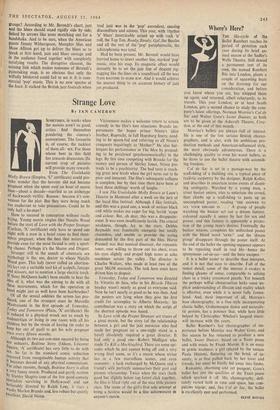Crossed Lines
By HUMPHREY LYTTELTON The latest intrepid explorer to try is Joachim Berendt, an intelligent, knowledgeable ,and methodical jazz critic from Germany. His book, The New Jazz Book,* in fact produces nothing very new in the way of theory or observation. With great lucidity, it sets out all the known facts and tested theories about the music's develop- ment, in a manner which will undoubtedly assist the newly enrolled jazz fan. There is one of those charts tracing the line of descent from Ragtime to Hard Bop—and looking for all the world like a map of the Underground. 'Change at COOL for TRISTANO SCHOOL, WESTCOAST, EXPERIMENTS and CLASSICISM.' It is This neat little diagram which reveals the flaw in any methodical documenta- tion of jazz.
`The evolution of jazz' (with the blues as the backbone •of the entire evolution) looks very simple set out as two parallel lines with inter- communicating lines shooting back and forth. But a factual graph of the interrelation of jazz and the blues would show the lines, not parallel, but intertwined like' the stems of a convolvulus. Jazz has not always been on the best of terms with its backbone, which in turn has acquired several pronounced curvatures trying to disso- ciate itself from the jazz body. The ruled lines of the chart take no account of the modern jazzmen who refer to work in rhythm 'n' blues bands as `paying your dues,' of saxophonist Sonny Rollins, , who has asserted that he would sooner not train * Peter Owen, 30s. his son in music at all than expose him to the risk of R 'n' B, or of blues singer Big Bill Broonzy, who ended his autobiography, 'When you write about me, please don't say I'm a 'jazz musician.'
Mr. Berendt should have been at the fourth National Jazz and Blues Festival at Richmond a week or two ago. The prevailing atmosphere of schizophrenia would have sent his neat parallel lines recoiling from each other like the tails of two warring scorpions. Schizophrenia was inherent in the programme which offered the Rolling Stones on the Friday night and, the following afternoon, the Tubby Hayes rehearsal big band playing a programme of original cm' positions. Within the ranks of Long John Baldry's Hoochie Coochie Men, this schizo- phrenia took on human shape. On our right, young musicians conforming in dress and coiffure to the conventional, hairy `beat' pattern. On our left, Ian Armit and Al Gay, both well past thirty, both experienced and well-known jazz' men, and both disqualified, not only by the de- predations of nature but by deep-rooted in- hibition, from matching the shaggy appearance of their younger colleagues. And in the middle, Long John Baldry himself, insisting that he is a blues singer, not a rhythm 'n' blues Man, and proclaiming his ambition to sing with Count Basic.
Backstage, in the paddock around the musicians' bar-tent, the atmosphere was un' usually strained. 'My friends won't speak to Inc now,' said one renegade jazz saxophonist sadly to an ex-colleague, 'but I've got to eat.' The eIt' colleague's face said 'Why?' so eloquently that the conversation shrivelled like a flea on a hot coal. Manfred Mann, once a modern jazz pianist who wrote articles on How To Play Jazz, seemed genuinely tortured, by the knowledge that lus latest `single" was hurtling to the top of the Top Ten. When a very teenage fan darted backstage, and presented him with a parcel which turnea out to contain a doll, he went positively green,
What had gone wrong? Why the discomfiture' the non-speaks, the splitting-up into separate groups? According to Mr. Berendt's chart, jazz and the blues should stand rigidly side by side, linked by arrows like arms stretching out for a handshake. And to be sure, when the American guests Jimmy Witherspoon, Memphis Slim and Mose Allison got up to deliver the blues so to speak at first hand, jazz and blues onstage and In the audience fused together with completely satisfying results. The disruptive element, the missing link which makes nonsense of Berendt's painstaking map, is so obvious that only the Wilfully blinkered could fail to see it. It is com- mercial 'pop' music. This is no new 'spectre at the feast. It stalked the British jazz festivals when trad jazz was in the 'pop' ascendant, causing discomfiture and schism. This year, with 'rhythm 'n' blues' inextricably mixed up with rock 'n' roll, the Top Ten, Ready, Steady, Go!, the Beatles and all the rest of the 'pop' paraphernalia, the schizophrenia was total.
Had he been present, Mr. Berendt would have hurried home to insert another line, marked 'pop' music, into his map. Its magnetic effect would instantly be to set the jazz line of descent zig- zagging like the lines on a soundtrack all the way from RAGTIME to HARD BOP. And it would achieve the nearest thing to an accurate history of jazz yet produced.



































 Previous page
Previous page